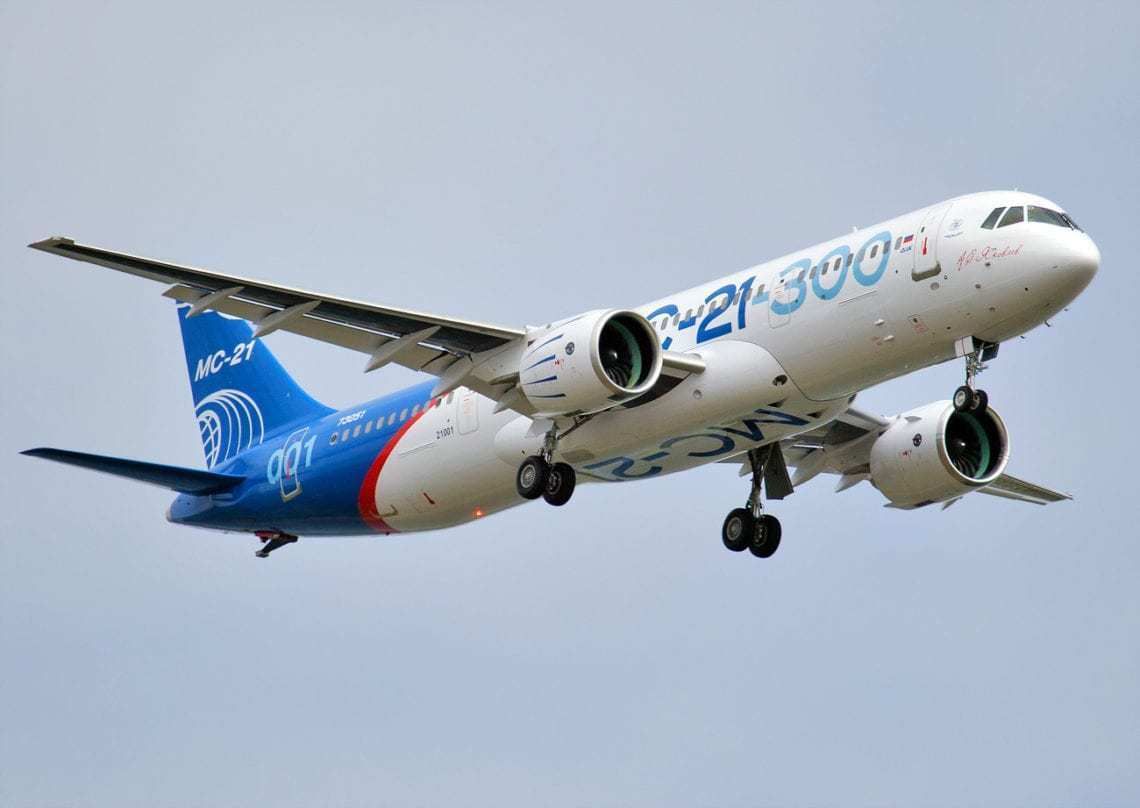Russia are busy working on their answer to the Boeing 737 MAX aircraft and are planning to debut their development this summer. The Irkut MC-21, complete with passenger interior, will be shown for the first time at the Moscow International Aviation and Space Salon (MAKS 2019), which runs from August 27th to September 1st this year.The launch of the MC-21 comes following Saturday’s third successful test flight for the aircraft. It is hoped that the airliner will receive certification in 2020. Produced by the United Aircraft Corporation (UAC), they have pegged it as a potential competitor to the 737 MAX.
Russian Minister of Industry and Trade, Denis Manturov, commented that the presentation would “visually demonstrate to potential customers and future passengers one of the most important competitive advantages of the Russian airliner – an increased level of comfort,â€
16 марта 2019 года на аÑродроме ИркутÑкого авиационного завода ÑоÑтоÑлÑÑ Ð¿ÐµÑ€Ð²Ñ‹Ð¹ полет третьего опытного Ñамолета МС-21-300.
ПродолжительноÑÑ‚ÑŒ полета ÑоÑтавила 1 Ñ‡Ð°Ñ 30 минут, он проходил на выÑоте до 3500 метров при ÑкороÑти до 500 км/чаÑ.https://t.co/TuNFtyeEW3 pic.twitter.com/4cTnqhRTc3
— United Aircraft Corp (@UAC_Russia) March 16, 2019
What is the MC-21?
The Irkut MC-21 is a single aisle jet which has been under development in Russia for over 12 years. Design began in 2006 with introduction slated for 2012. However, in 2011, the launch was delayed until 2020, and the first MC-21-300 was rolled out on June 8th, 2016. It took its first flight on 28th May 2017.
Production of the aircraft has been further hampered by US sanctions, which have cut off access various products, in particular to composite wing materials. As a result, Russia has enough material to build just six more planes. They will need to create their own industry in composite materials if they are to begin mass production.
Is it really a competitor to the 737 MAX?
As the most popular aircraft in history, the 737 is well known to carriers and passengers everywhere. However, with recent issues seeing the modern iteration of the aircraft grounded, confidence in the line has certainly been shaken.
However, despite Boeing’s current woes, it would take a mammoth effort to make a dent in their market share. And with stiff competition from the Airbus A320 family too, what hope does the MC-21 really have of breaking into the mass market?
Let’s take a look at the aircraft and what it’s planning to bring to aviation.
|
Type |
MC-21-200 |
MC-21-300 |
|
Seats (in two class) |
132 (12J and 120Y) |
163 (16J and 147Y) |
|
Seats (in one class) |
165 |
211 |
|
Length |
36.8m (121 ft) |
42.2m (138 ft) |
|
Wingspan |
35.9m (118 ft) |
|
|
Height |
11.5m (38 ft) |
|
|
MTOW |
72,560 kg (159,970 lb) |
79,250 kg (174,720 lb) |
|
Range (in two class) |
6,400 km (3,500 nmi) |
6,000 km (3,200 nmi) |
In comparison to the 737 MAX family, there are some striking similarities. Although the passenger capacity of the MC-21-200 is lower than any of the MAX aircraft, the MC-21-300 straddles the capacities of the MAX 8 and MAX 9 very neatly. The length of the two models, again, is a neat fit with the MAX 8 and MAX 9 respectively.
However, where it really falls down is in its maximum takeoff weight (MTOW), which at 72,000kg for the smaller version is almost 8,000 kg less than the smallest of the MAX family. Even the larger MC-21-300 has a lower MTOW than the MAX 7, which could be a big deal for carriers looking to operate the aircraft.
Will it be a success?
The success or failure of the MC-21 will come down to price and availability. UAC have indicated that they can only produce 10 MC-21s in the first year rising to 20 in the second, but will be reliant on a supply industry being developed locally in order to achieve this.
As of the end of 2018, they had received 175 orders for the aircraft, including 50 from Aeroflot. Aeroflot had also ordered a number of 737 MAX aircraft for their low cost arm, Pobeda, but have been said to be mulling over cancellation as a result of the recent accidents.

